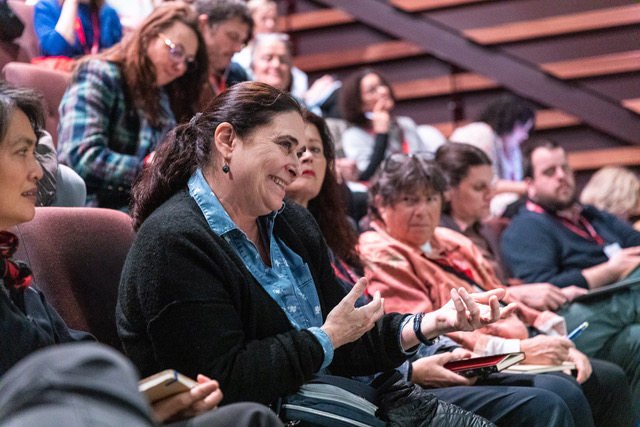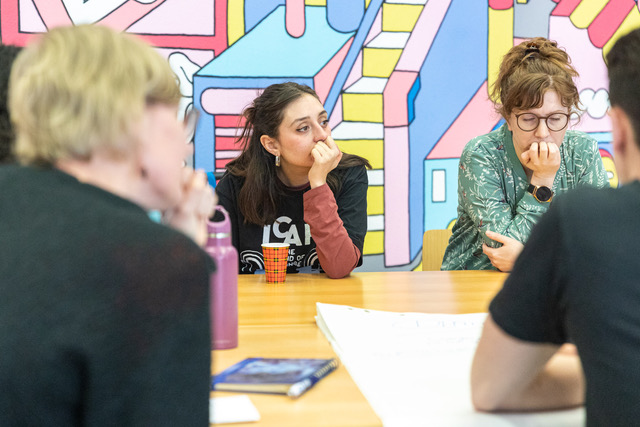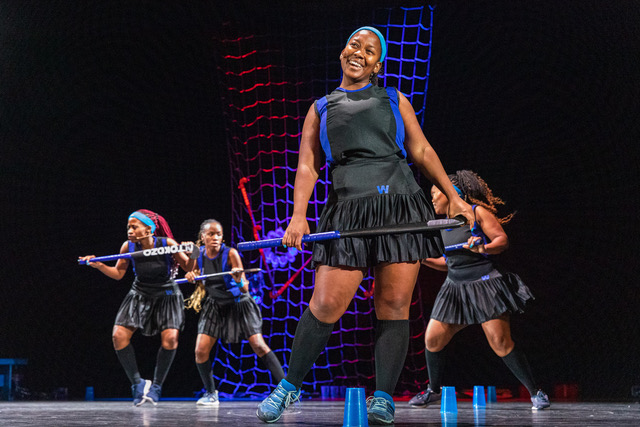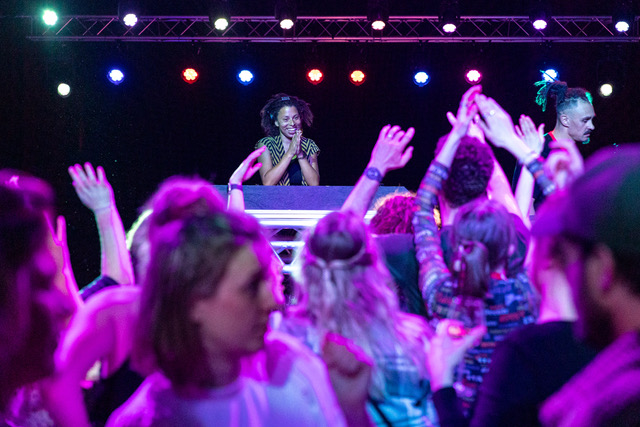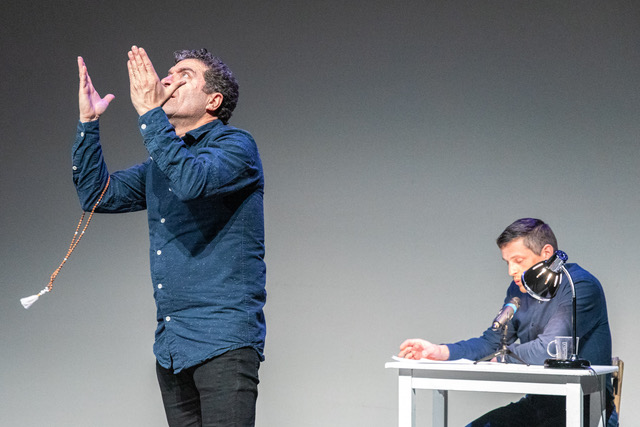The work of community artists is inherently diverse and in a perpetual state of change. We continue to explore, refine, and reinvent this calling that draws us all together across our differences and geographies. Our theme this year at ICAF is The Sound of Change. Even within the simplicity of these words, there room for finding fresh interpretations and meanings. In English, the word sound contains a range of rich possibilities.
When used as a verb, sound means to make known. Let us sound the alarm.
When used as an adjective, sound means free from injury or disease. She is in good health, of sound mind, body, and spirit.
As an adjective, sound can also mean well thought out. Their reasoning is sound.
As an adverb, sound can mean thoroughly and completely. The children are all sound asleep.
And when used as a noun, a sound is a body of water that serves as the place in which other bodies of water come together. In western Canada, the waters of several small inlets flow into Forward Inlet, where they all converge at Quatsino Sound before they meet the Pacific Ocean.
Each new day, as the program unfolds here at ICAF, we are experiencing vital new ways of understanding what it means to embrace the sounds of change.
On Friday, I began the morning by attending James Thompson’s lecture, “Care Aesthetics.” Through his writings over the years, James has always generously shared with this community his ever-evolving practice in applied theatre and socially-engaged arts. His most recent set of investigations challenge fundamental notions of what theatre is and can be. I first encountered James through his 2003 book Applied Theatre: Bewilderment and Beyond. In those pages I found a man who resolutely foregrounded care in the work of theatre artists. He wrote about theatre as a potential space of refuge for people whose lives had been upended by traumatic events. He introduced the idea of what he called “garlanding” or “wrapping people in.”
“[W]ho is to say that relief is not a legitimate part of applied theatre? ‘Wrapping people in’ might be the way that theatre works within a particular setting. A theatre of relief has value. It might act to protect, find coherence, bind and join individuals and communities at a time of extreme dislocation or bewilderment. Moments of major social or personal upheaval can therefore be eased, smoothed and secured by an engagement with forms of theatre that relieve, remind, warm and sooth. Singing, dancing, laughing and celebrating are thus an applied theatre in times of crisis because they provide a space of relief within the dangerous place of bewilderment.” (page 201).
In his conversation with us today, James described an even greater commitment to ‘garlanding.’ He invited us to consider how care is embedded in the relationships of power and equality among people as we engage with each other. Words like “attention” and “attunement” and “reciprocity” and the focus on the body through the sense of touch, through movement and rhythm, are elements that he has carried in his work all along. However, there is palpable a shift here into a deeper register of care. What if working with care was not a layer added on to the work of our practice as community engaged artists? What if care was the work itself?
In my personal life and my professional work in Canada, I am always trying to honour the first peoples of that land by taking time to learn about the wisdom built into Indigenous ways of knowing. One way involves learning about the languages spoken by Indigenous peoples. For example, I have learned that in the Cree language (called nēhiyawēwin in their own language) they use the suffix ihkān or -ohkān. By adding the suffix –ihkān or -ohkān to an actual thing, it makes it into the word for the artificial thing. Pīsim means moon/sun. When the suffix -ohkān is added it becomes pīsimohkān, which means a clock. Mōhcw means foolish. Mōhcohkān is a clown. Awāsis means a child. Awāsisihkān is a doll.
(These words are in the online book Cree: Language of the Plains https://ourspace.uregina.ca/handle/10294/8401
I find myself wondering whether this is related to the conceptual leap that James is inviting us to consider. In our work as community artists we are privileged to encounter the lives of the people with whom we work. Sometimes we make plays with them. What if we are going about this work of playmaking by thinking of theatre as the suffix that turns their actual lives into the artificial versions of their lives? What are the implications of thinking of theatre as a means of a performance of the thing itself. It seems like quite a stretch of the imagination, but is it really? In the most compelling performances we are seeing here at the festival, whether on stage or in workshop studios, what is it that makes the whole room gasp, or giggle with glee, or sit with tears welling in the eyes? I suggest that it is those moments in which we see the actual lives of people in relationship to each other, or to their situations, momentarily and genuinely embodied. Not a play about the thing, but a performed embodiment of the thing itself. Is this the portal that James is inviting us to step through?
In the afternoon, I joined the group attending the short workshop presented by Sanjana Kumar and Andy Barrett. They shared their project methodology, which is designed to test how effectively applied theatre can be used as a means to elevate mental health literacy among people in Rural and Urban Kerala, India. Appearing in a video introduction, their colleague Dr. Raghu Raghavan spoke supportively of the power of theatre as “a contract with the heart that only art can do.” What struck me in this work was how their aspiration overlapped with the sensibility James Thompson had shared in the morning. They, too, are stepping away from the expectation that the performance of an applied theatre play is only considered effective if it produces a palpable outcome of social change. It seems we are moving beyond that expectation, and that “burden of proof.” This alternate paradigm involves performance that will nurture a way of seeing and feeling.
When I was a teenager in the 1970s, one of the social concerns in the news was the potential extinction of the California Condor, a magnificent bird. I remember attending a big rally in support of efforts to save this species. I stood in the crowd and looked to the stage where a woman approached the podium to speak. Leaning into the microphone, she said: “It’s not important that we save the California Condor.” I was immediately flushed with outrage. What is she saying? What could she be thinking? Why is she even here? And then she continued: “It’s not important that we save the California Condor: what’s important is that we become the kind of people who want to save the California Condor.” That moment is seared in my imagination and the memory came back as I listened to Sanjana and Andy talk about their work. The conversations generated among the audiences that attend their plays are unlikely to bring about radical policy change as a direct result of the performances. Perhaps, though, they will lead to family members, friends and co-workers of individuals navigating mental health challenges to become the kind of people who now know what to look for and how to respond with knowledge and care.
Similarly, in one of the 7pm evening performances, actor Ali Shafiee used a poetically elevated Dutch Sign Language to perform his autobiographical story of fleeing Iran at the age of 19. Produced by Theatre Group Signum, with Arthur Massoers’s voice interpreting in English, Stille Vlucht / Silent Flight is intended to open awareness as deaf and hearing cultures are brought together through theatre performance. Here was a variation of the same theme I witnessed this morning. In this case “the thing itself” was the way Ali shared his tale. Of course sign is a language of communication like the many languages being spoken by the festival attendees at ICAF. The difference here was that so much of his experience wasn’t mediated by the sounds of words to convey meaning. Through much of the performance, we in the audience were able engage directly with his experience, as it was being played out in the performer’s body and face. This wasn’t silence as a void or an absence; it was silence filled with meaning.
I could write volumes about the final performance of the night, The Whistleblowers, from Johannesburg, South Africa. As I am nearing the end of my allotted word count for today’s blog, I will be brief. As a man encountering this show, I was both honoured and shattered. Honoured because these extraordinary performers invited me/us all into witnessing what it is to be a young South African woman growing up in Johannesburg, a city considered statistically to be “the rape capital of the world.” In their genuine and honest portrayals of five vibrant young friends on a hockey team, they revealed their resilience, joy, and love for life always in constant resistance to the threat of sexual violence and harassment they face every day. And again, the staging didn’t feel like a play as such. They embodied feelings and relationships in a way that seldom felt like a scenes in a script. For me it was more like a flowing invitation to us to look closely at the facets of their lives. They spoke in English, Afrikaans, Zulu, and Xhosa, and yet with an understanding of only one of those languages, I was able to understand exactly what was happening moment to moment to sometimes anguishing moment. That alone made it feel like we were experiencing “the thing itself.” And then, following the final bows after the performance, “the thing itself” truly came into being as one of the performers explained that the numbers on the backs of their hockey jerseys were references to rape statistics in South Africa; that the names painted on their hockey sticks were the names of actual women who have been victims of sexual violence. They explained that when they first began, they hadn’t intended to make this play but after talking with one another they realized that they had to make it. They closed with one of the women declaring that their performances are dedicated to all the women who face sexual violence and harassment. “We play not only for ourselves,” she said, “we play for you.”
This is the aesthetic of care.
More to come tomorrow,
Will
